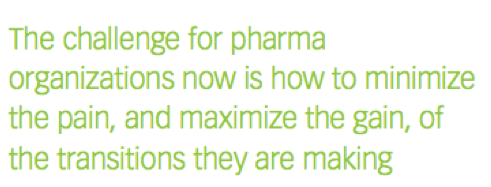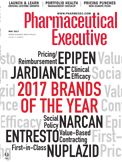Life Sciences' Shifting Sands: 5 Trends that Threaten the Status Quo
Pharmaceutical Executive
If pharma companies want to hold their own in the current climate, they must embrace rather than resist market change.
Change is the only constant in the new normal, something that applies as much to life sciences now as to other markets more readily associated with disruption, such as retail and banking. But the pharmaceutical industry is not known for its adaptability, so how will it weather the choppy conditions currently characterizing the market-and can technology ease the strain?
Here are five growing trends that are likely to challenge business as usual, unless companies take preemptive measures.
Acquisition appetite
Merger and acquisition activity is buoyant at the moment, with little sign of this changing any time soon. PwC calculated that 101 transactions were announced in the pharma and life sciences sector in Q4 2016, worth $34.4 billion.
The need to align content and label assets, update company information and standardize on key wording, registered symbols and logos according to the controlling organization’s style guide is clearly an important part of blending portfolios. It is critical to upholding brand image, stabilizing compliance efforts and maximizing process efficiency-not to mention market opportunity.
Yet checking content assets manually against an approved master and verifying that they meet the rebranding criteria is a laborious task-one that increases exponentially with each SKU (variation of product). Automating this process using technology that can compare and accurately spot and highlight anomalies-at high speed across huge batches of content assets-can reduce the time taken by as much as 85%. This can have a tangible impact on speed to market with products under new ownership-keeping stock moving and providing valuable savings.
OTC/generic drugs growth
The growing global over-the-counter (OTC) drugs market, and increasing emphasis on generic medications, is another driver of upheaval for the pharma industry with an impact on the way manufacturers must manage efficiency and the accuracy and consistency of marketing and patient safety information.
Pressures on health services in markets such as the UK-whether that’s to get an appointment with a clinician for a consultation about minor ailments, or to qualify for a subsidized or free prescription-are prompting more people to go to local pharmacies, supermarkets and extended-hours convenience stores for the medication they need. Technavio suggests the global OTC drug market will be worth $162 billion by 2020. In the meantime, large volumes of branded drugs will see their patents expire, leaving a gap that could be filled by generic products.
Where patients are paying for their own drugs over the counter, cost becomes a conscious consideration, prompting them to choose stores’ own brands-reassured by media campaigns that the active ingredients are more or less the same. Clinical prescribers (hospitals and community medical teams) have a growing interest in generic drugs, too, because of the pressure to keep their own costs down.
But these products have typically been handled by more parties in the supply chain, and manufacturers must ensure this doesn’t compromise quality and safety. This demands robust quality checks of labeling and patient leaflets. As information is updated in the light of emerging contra-indications or the discovery of new side effects, for instance, these must be reflected across all affected products. Strict deadlines apply in such cases, so companies need to move quickly.
Again, it comes down to finding reliable automation solutions, such as automatic text verification, that can reduce packaging complexity while instilling confidence that nothing will slip through the net.
The impact of digital channels
As patients are encouraged to take more responsibility for their own health, drug companies are turning to digital channels. Publishing information online is more cost-effective, too, and easier to update quickly. In the US, it is becoming increasingly common for brands to have product-specific microsites-where they can drive traffic captured via social media, for instance.
For safety’s sake, digital information formats must also include the relevant prescribing dose and safety information. Hence, it is vital that companies are able to manage and coordinate these channels alongside traditional, physical patient leaflets-ensuring that messaging is consistent and accurate across the board. Practically, this means being able to check content in XML or HTML formats as well as traditional PDFs and text or Word files.
Cross-border compliance efforts
International harmonization efforts, such as the European Medicines Agency’s IDMP (identification of medical products), are in everyone’s interests and should make life much easier when there are far fewer authorities to publish product information to. But for the time being, global life sciences players still need to put in a lot of work to ensure that they are meeting the quality and safety standards in each individual market.
This can be a tall order, given the varying emphases, not to mention language, phrasing and symbol differences between countries. Checking content across different languages and cultures presents its own issues because of the subtle differences in interpretation of particular phrasing. Unless the parties responsible for checking translations are completely fluent in multiple languages, the scope for error is significant.
It is important, therefore, that teams have the backup of sophisticated software to smooth the process and highlight anomalies. One reliable way to do this is by comparing the code behind the characters to be printed-allowing two files to be compared in any language and any font, as long as they support Unicode.
In the climate firms are now operating in, prevention (of problems) is more cost-effective than cure, so tools that allow the industry to be on the front foot have much in their favor.
Skills challenges
It is becoming increasingly challenging for life sciences companies to attract and retain the right skills for regulatory and quality purposes. More experienced roles require a blend of regulatory expertise and commercial knowledge, and in some cases it is now taking companies up to a year to appoint new people.
In Europe, the situation is likely to get worse before it gets better. Brexit and the free movement of labor in Europe; increasingly complex compliance requirements; the expanding presence of pharmacovigilance; and the stress placed on those responsible to be absolutely meticulous in the accuracy of product information are all

having an impact on a firm’s ability to build and maintain the teams it needs.
In a recent study by international people and organizational advisory firm Korn Ferry, almost three-quarters (73%) of employees said that their primary motivation at work was doing a job that had meaning and purpose. This is at odds with pharma’s use of skilled scientific writers to proofread patient materials-a laborious and unfulfilling task that could be filled by automated tools. So here, too, companies need a rethink about how they allocate resources.
Change may not always be welcome, but it can be healthy-and necessary-for a market. The challenge for pharma organizations now is how to minimize the pain, and maximize the gain, of the transitions they are making. Targeted automation can help and, in a labeling and packaging context, this can ensure that companies derive considerable business advantage-from accelerated speed to market and lower operational costs, to better use of staff. That’s on top of risk reduction gains. So any investment made to draw out those benefits will be one well made.
Peter Muller is Managing Director, Schlafender Hase, Americas. He can be reached at peter.muller@sh-p.de

Is Artificial Intelligence a ‘Product’? Products Liability Implications for AI-Based Products
April 10th 2025As the physical products we use evolve to become increasingly complex, traditional products liability frameworks may not always fit to provide remedies for harm that can result from using novel product types.